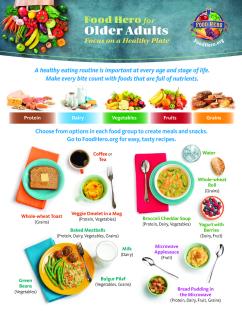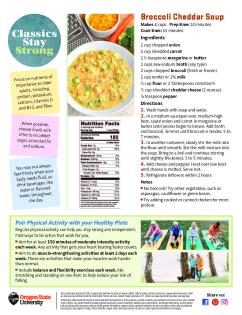Focus on a Healthy Plate
A healthy eating routine is important at every age and stage of life. Make every bite count with foods that are full of nutrients.
Food Groups
- Protein
- Dairy
- Vegetables
- Fruits
- Grains

Choose from options in each food group to create meals and snacks. Go to FoodHero.org for easy, tasty recipes.
Examples of Meals
- Whole-wheat Toast (Grains), Veggie Omelet in a Mug (Protein, Vegetables), Coffee or Tea
- Broccoli Cheddar Soup (Protein, Dairy, Vegetables), Yogurt with Berries (Dairy, Fruit), Whole-wheat Roll (Grains), Water
- Baked Meatballs (Protein, Dairy, Vegetables, Grains), Green Beans (Vegetables), Bulgur Pilaf (Vegetables, Grains), Milk (Dairy)
Examples of Snacks
- Microwave Applesauce (Fruit)
- Bread Pudding in the Microwave (Protein, Dairy, Fruit, Grains)
Classics Stay Strong
- Focus on nutrients of importance to older adults, including protein, potassium, calcium, vitamins D and B12, and fiber.
- When possible, choose foods with little to no added sugar, saturated fat and sodium.
- You may not always feel thirsty when your body needs fluid, so drink beverages, like water or flavored water, throughout the day.
Pair Physical Activity with your Healthy Plate
Regular physical activity can help you stay strong and independent. Find ways to be active that work for you.
- Aim for at least 150 minutes of moderate intensity activity each week. Any activity that gets your heart beating faster counts.
- Aim to do muscle-strengthening activities at least 2 days each week. These are activities that make your muscles work harder than normal.
- Include balance and flexibility exercises each week, like stretching and standing on one foot, to help reduce your risk of falling.




